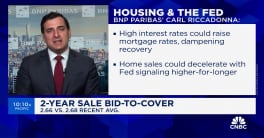Home builders, who have been feeling the squeeze on the selling side of their business for months, are now reporting that they are caught in a crunch on the development side as money for land acquisition, development, and home construction is drying up.
While the spill-over from the subprime crises has made credit difficult to obtain on many levels and for many businesses, the National Association of Home Builders claimed this week that pressure on home builders is growing worse.
Bob Mitchell, a home builder from Rockville, Maryland and former president of the NAHB testified this week before the Senate Small Business Committee's hearing on "Impacts of the Credit Crunch on Small Firms," telling members that, "This credit crunch actually appears to be worsening despite the concerted efforts of central banks here and abroad. Tighter mortgage lending terms have made it difficult for home buyers to obtain financing to purchase new homes. Likewise, there have been dramatic adverse swings in the cost and availability of AD&C loans for home builders."
Builders use AD&C loans (Acquisition, Development, and Construction) to purchase land, develop lots, put in infrastructure such as streets and sidewalks, lighting, utility connections; and to build the actual houses.
Mitchell told the senators that funding for residential development and construction projects has been severely limited or blocked completely at federally insured depository institutions. These are, he said, the sole source of credit for these types of projects for the small businesses that comprise most of the home building industry. There is also no secondary market for residential construction money to which local lenders could turn for additional liquidity.
He noted that such a secondary market would directly benefit builders and lenders by transferring risk away from the lenders, increasing the availability of funds and mitigating the impact of equity calls on builders or the transfers of partially completed projects to banks under capital or regulatory pressure.
Mitchell called for participation on the part of many components of the private and public sectors to build such a market for AD&C loans. Among his suggestions:
- Government Sponsored Entities: Fannie Mae should increase activity in its existing AD&C loan purchase program while Freddie Mac creates a similar program;
- Federal Home Loan Banks: housing production loans should be accepted as collateral for secured advances to member institutions;
- The Federal Housing Administration: Competition in the secondary market would be increased by federal insurance of the construction portion of these loans in order to attract new originators such as mortgage banking companies.
- Wall Street: Changes to tax provisions relating to Real Estate Mortgage Investment Conduits and Taxable Mortgage Pools would be helpful in securitizing construction loans and Wall Street could develop prototype private security instruments for AD&C loans.
- Banking Regulators: A balanced approach when evaluating bank lending is crucial in regard to these loans. "Small businesses, including small builders, are vital to the economy and arbitrary or unreasonable regulatory restrictions would only serve to harm many builders, and potentially, many banks," said Mitchell. "It would be ironic and tragic to have the positive work of the Fed undone by bank regulators taking a totally different vision and approach when it comes to lending matters."
Mitchell, in his testimony, also called for passage of the housing stimulus measures recommended earlier by NAHB. Several of these measures are contained in bills being considered by the House, the Senate, or committees trying to reconcile different House and Senate versions, but in some cases Congress did not go as far as NAHB would like. The organization's wish list, as enumerated by Mitchell, would include a temporary home buyer tax credit that NAHB sees stimulating a "wave of buying that could quickly reduce excess supply in housing markets and halt the dangerous erosion of house prices and mortgage credit quality."
Other provisions include expanding the carryback of net operating losses beyond the current two years. NAHB has suggested a carryback of five years which it claims would help all types of businesses that have been hit hard in the current economic climate, including financial institutions and manufacturers, and would provide flexibility for home builders with large land holdings to reduce their inventories in an orderly fashion to stabilize home and land prices.
Finally, approving a temporary $10 billion expansion of the mortgage revenue bond program would help strapped borrowers seeking to refinance their own homes. Expanding the reach of the program would allow it to have the largest effect particularly in communities experiencing the possibility of a wave of foreclosures or an extreme excess of inventory.







